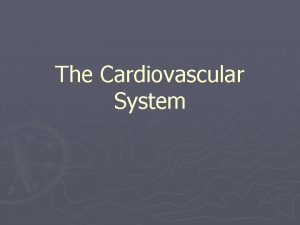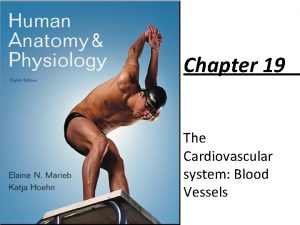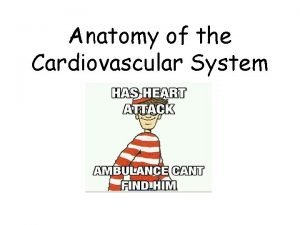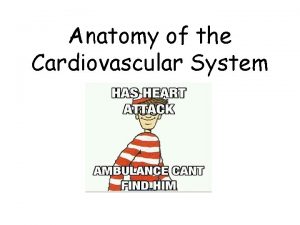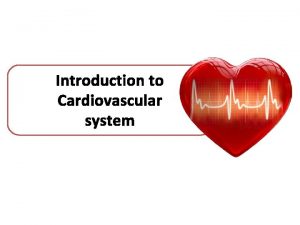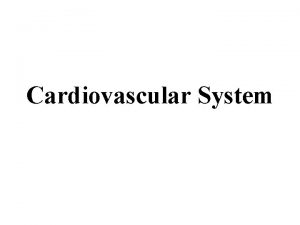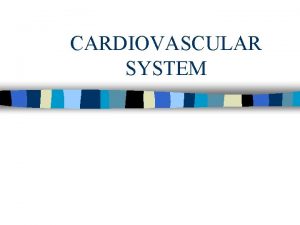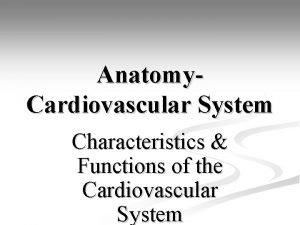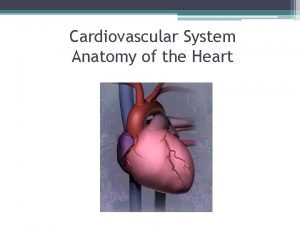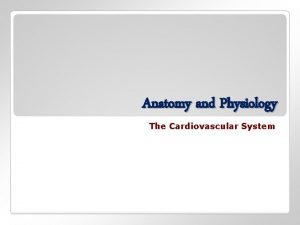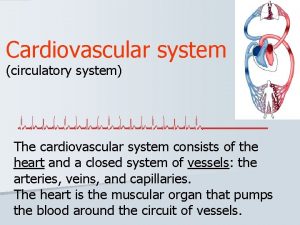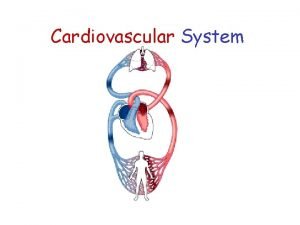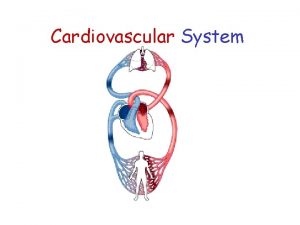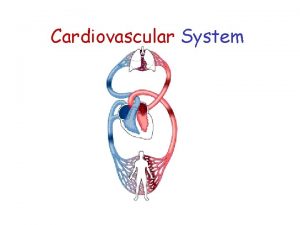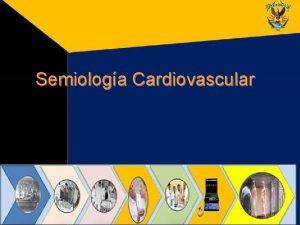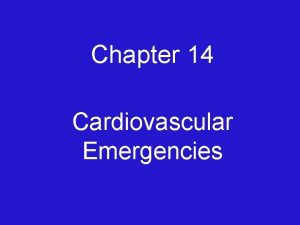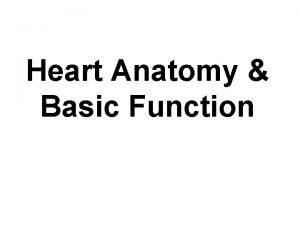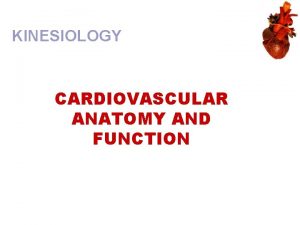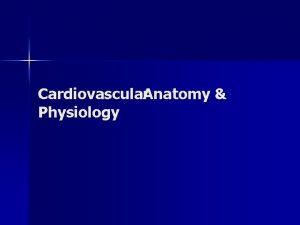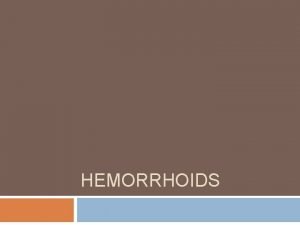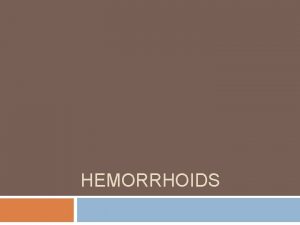Anatomy of the Cardiovascular System Cardiovascular System Also














































- Slides: 46

Anatomy of the Cardiovascular System

Cardiovascular System • Also circulatory system • Consists of: the heart, arteries, veins, capillaries

Heart • Four chamber muscular organ • Comparable to the size of a closed fist • Located in the mediastinum

Heart

Coverings of the Heart • Pericardium – loose fitting sac surrounding the heart – Fibrous pericardium – tough, loose-fitting, inelastic – Serous pericardium • Parietal layer: lines the inside of the fibrous pericardium • Visceral layer: adheres to outside of the heart – Pericardial space: between parietal and visceral layer • Filled with 10 -15 m. L of pericardial fluid • Decreases friction

Walls of the Heart • Epicardium – outer layer – Epicardium = serous pericardium • Myocardium – thick, contractile layer composed of cardiac muscle cells • Endocaridium – interior of cardiac wall

Walls of the Heart

Chambers of the Heart • Atria – two superior chambers – “Receiving chambers” – Blood from veins enters atria • Ventricles – two inferior chambers – “pumping chambers” – Separated by interventricular septum

Valves of the Heart • Permit blood flow in one direction during circulation • Atrioventricular valves (AV valves) – Also cuspid valves – Between atria and ventricles • Semilunar (SL valves) – Between ventricles and vessles

Chambers & Valves Trace the blood flow through the heart

Blood Supply to the Heart • After traveling through the capillaries of the heart, blood empties into the Right atrium via the vena cavas

Conduction System of the Heart • Sinoatrial Node (SA Node) – Pacemaker of the heart – 100 s of cells in the R atrium near the opening of the superior vena cava • Atrioventricular Node (AV Node) – Left lower border of R atrium

Types of Blood Vessels • Artery – carries oxygenated blood away from the heart – Arteriole: small artery – Precapillary sphincters: regulate the blood flow into capillaries

Types of Blood Vessels • Vein – carries unoxygenated blood towards the heart – Venules: small vein

Types of Blood Vessels

Types of Blood Vessels • Capillaries – arterial system switches to venous system – “primary exchange vessels” – Transport materials to and from the cells – Speed of blood flow decreases to increase contact time

Types of Blood Vessels

Structure of Blood Vessels • Tunica adventitia - outermost layer – Fibrous connective tissue – Holds vessels open; prevents tearing of vessels walls during body movements – Larger in veins than arteries • Tunica media – middle layer – Smooth muscle and elastic CT – Helps vessels constrict and dilate – Larger in arteries

Structure of Blood Vessels • Tunica intima – innermost layer – Composed of endothelium – Semilunar valves present in veins – One cell thick in capillaries

Circulatory Routes • Systemic Circulation – blood flow from the L ventricle to the body & back to the R atrium • Pulmonary Circulation – blood flow from the R ventricle to the lungs and back to the L atrium

Circulatory Routes

Aorta

Systemic Arteries • • Arch of aorta Subclavian (L and R) Brachiocephalic common carotid (L and R) Axillary (L and R) Brachial (L and R) Radial Ulnar • • Abdominal aorta Common iliac External iliac Femoral Popliteal Posterior tibial Anterior tibial Dorsal pedis


Systemic Veins • • • Superior vena cava Inferior vena cava External jugular Internal jugular Brachiocephalic (L and R) • Subclavian (L and R) • Cephalic • axillary • • • Basilic Median basilic Median cubital Common iliac External iliac Femoral Popliteal Great saphenous Small saphenous


Pericardium Disorders • Pericarditis – inflammation of the heart – Causes: trauma, viral or bacteria infection, tumor – Edema causes visceral and parietal layers to rub together = chest pain – Pus or blood build up in pericardial space – S/S • Pain with respirations or coughing, dyspnea, restlessness – Complications: Pericardial Effusion, Cardiac Tamponade – Treatment: • Antibiotics, pain meds, antiinflammatory meds, pericardiocentesis (Cardiac Tamponade)

Heart Valve Disorders • General Principles: – Congenital defect: decreased pumping efficiency – Incompetent valve leak: allows backflow into previous chamber – Stenosed valves: narrowed valve; slowing blood from out of chamber

Heart Valve Disorders • Mitral Valve Prolapse (MVP) – Flaps of mitral valve extend back into L atrium causes leaking – Mostly genetic basis – 1 in 20 people – S/S: most asymptomatic; chest pain, fatigue – Treatment: valvuloplasty

Mitral Valve Prolapse

Heart Valve Disorders • Aortic Regurgitation – Blood leaks back into L ventricle during ejection into the aorta – Volume overload in L ventricle, hypertrophy, dilation of L ventricle – Complications: myocaridal ischemia – Treatment: valvuloplasty

Myocardium Disorders • Atherosclerosis – Type of arteriosclerosis – Lipids build up on the inside of vessel walls calcify vessels hard & brittle – Risk factors: cigarette smoking, high fat/cholesterol diet, hypertension

Atherosclerosis

Myocardium Disorders • Myocardial Infarction – – “Heart Attack” Coronary thrombosis: clot Coronary embolism: mobilized clot Occlude coronary artery heart tissue deprived of oxygen cell death – S/S: • Angina pectoris – severe chest pain resulting from inadequate oxygen to myocardium – Treatment: Coronary Bypass Surgery • Veins are harvested from other areas of the body and used to bypass obstructions


Myocardium Disorders • Congestive Heart Failure (CHF) – “Left-sided Heart Failure” – Inability of the L ventricle to pump blood efficiently – Causes: myocardial infarction – S/S: decreased pumping pressure in systemic circulation; retained fluids • Can lead to congestion in pulmonary circulation pulmonary edema right-sided heart failure – Treatment: heart transplant

Congestive Heart Failure

Myocardium Disorders • Coronary Artery Disease (CAD) – Leading cause of death in US – General term to describe decreased blood flow to myocardium & associated side effects

Disorders of the Arteries • Arteriosclerosis – Arteries become occluded, weak and hardened – Complications: ischemia, necrosis, gangrene – Risk factors: age, diabetes, high fat/cholesterol diet, hypertension, smoking – Treatment: vasodilators, angioplasty, stent placement, bypass surgery – Complications: aneurysm

Angioplasty

Disorders of Veins • Varicose Veins – Enlarged veins caused by pooling – Results in varicosities or varices (“spider veins”) – Risk factors: standing for long periods • Semilunar valves widen more pooling – Treatment: compression stockings, surgical removal

Varicose Veins

Disorders of Veins • Phlebitis – vein inflammation – Causes: irritation by IV catheter • Thrombophlebitis – Deep vein thrombosis (DVT) – Phlebitis caused by a clot – S/S • Pain, redness, swelling – Complications • Pulmonary embolism

DVT

Pulmonary Embolism

Venous Stasis Ulcers • Result of chronic vein insufficiency • Lack of oxygen to peripheral tissues • Elevate leg & apply pressure • Irregular edges • “Aching” pain
 Anatomy and physiology unit 7 cardiovascular system
Anatomy and physiology unit 7 cardiovascular system The circulatory or cardiovascular system chapter 19
The circulatory or cardiovascular system chapter 19 What makes up the cardiovascular system
What makes up the cardiovascular system Pithed rat model
Pithed rat model Totally tubular dude
Totally tubular dude Crash course circulatory system
Crash course circulatory system Chapter 5 the cardiovascular system
Chapter 5 the cardiovascular system Figure 11-8 arteries
Figure 11-8 arteries Chapter 11 the cardiovascular system figure 11-10 answers
Chapter 11 the cardiovascular system figure 11-10 answers Lesson 11 cardiovascular system
Lesson 11 cardiovascular system Lesson 11 cardiovascular system
Lesson 11 cardiovascular system Agranulocytes
Agranulocytes Anatomy blood vessels
Anatomy blood vessels Introduction of cardiovascular system
Introduction of cardiovascular system Stent placement
Stent placement Chapter 8 cardiovascular system
Chapter 8 cardiovascular system Chapter 13 cardiovascular system
Chapter 13 cardiovascular system Chapter 11 the cardiovascular system figure 11-2
Chapter 11 the cardiovascular system figure 11-2 The cardiovascular system includes the
The cardiovascular system includes the Blood vesel
Blood vesel Venule
Venule Hát kết hợp bộ gõ cơ thể
Hát kết hợp bộ gõ cơ thể Ng-html
Ng-html Bổ thể
Bổ thể Tỉ lệ cơ thể trẻ em
Tỉ lệ cơ thể trẻ em Chó sói
Chó sói Glasgow thang điểm
Glasgow thang điểm Chúa sống lại
Chúa sống lại Các môn thể thao bắt đầu bằng từ đua
Các môn thể thao bắt đầu bằng từ đua Thế nào là hệ số cao nhất
Thế nào là hệ số cao nhất Các châu lục và đại dương trên thế giới
Các châu lục và đại dương trên thế giới Công thức tính thế năng
Công thức tính thế năng Trời xanh đây là của chúng ta thể thơ
Trời xanh đây là của chúng ta thể thơ Mật thư anh em như thể tay chân
Mật thư anh em như thể tay chân Phép trừ bù
Phép trừ bù Phản ứng thế ankan
Phản ứng thế ankan Các châu lục và đại dương trên thế giới
Các châu lục và đại dương trên thế giới Thơ thất ngôn tứ tuyệt đường luật
Thơ thất ngôn tứ tuyệt đường luật Quá trình desamine hóa có thể tạo ra
Quá trình desamine hóa có thể tạo ra Một số thể thơ truyền thống
Một số thể thơ truyền thống Cái miệng nó xinh thế chỉ nói điều hay thôi
Cái miệng nó xinh thế chỉ nói điều hay thôi Vẽ hình chiếu vuông góc của vật thể sau
Vẽ hình chiếu vuông góc của vật thể sau Biện pháp chống mỏi cơ
Biện pháp chống mỏi cơ đặc điểm cơ thể của người tối cổ
đặc điểm cơ thể của người tối cổ V. c c
V. c c Vẽ hình chiếu đứng bằng cạnh của vật thể
Vẽ hình chiếu đứng bằng cạnh của vật thể Phối cảnh
Phối cảnh


















